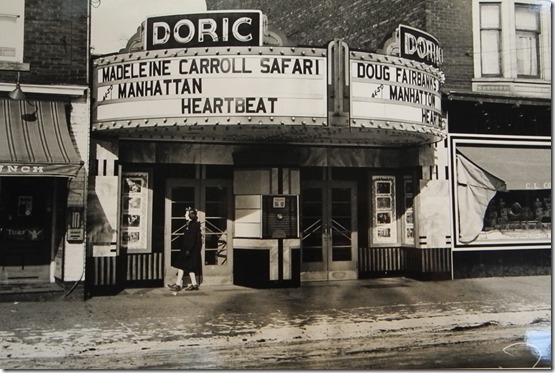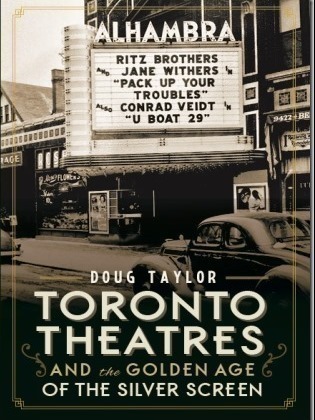The Doric theatre, January 18, 1941, photo from the Toronto Archives, Globe and Mail Collection, 71416
The Doric theatre at 1094 Bloor Street West was located close to Gladstone Avenue, on the north side of Bloor, a short distance east of Dufferin Street. The year that it opened is difficult to ascertain. The web site world-theatres.com indicates that it opened in 1919, although the collection of John Chuckman contains a postcard that advertises Mary Pickford playing in a film for Famous Players at the Doric in 1910. However, I must admit that the 1919 date seems the most likely. For certain, when the Doric opened, it was among Toronto’s earliest theatres.
The building containing the Doric Theatre was unusual, as it was only one storey in height. It was a small venue, possessing only 527 seats, so was truly a neighbourhood theatre that depended for patrons on those who lived within walking distance of it. Although I discovered no proof, the theatre most likely offered vaudeville and silent films as this was the standard format during the decade when it opened. To facilitate vaudeville, it required a small stage. I should imagine that the acts offered at the Doric would have been second rate or beginning performers, since the audience was too small for the management to be able to afford first-rate acts.
When it originally opened, its facade possessed two ionic columns that supported a portico. Beneath the portico, recessed back from the sidewalk were the entrance doors. Because the theatre was a single-storey building, there were no residential apartments above it to generate extra income to offset the expenses of the theatre. Also, as the building was quite small, squeezed between other structures, there was no space for rental shops either. Thus, the sole income of the theatre was derived from ticket sales. It only remained profitable as long as the movie house was well attended.
The façade of the theatre changed greatly in the decades ahead. By the 1940s, a new canopy had been installed, which contained the marquee. Its design was typical of many Toronto theatres during the 1940s and 1950s. However, there was no large electric sign above the marquee as there was no second storey. In its place, the word “Doric” appeared in bold letters on either side of the canopy. These signs were clearly visible at night when the marquee was ablaze with light.
The box office was in the centre of the entranceway, the theatre’s doors only three or four feet from the sidewalk. On either side of the doors were display spaces advertising the daily attractions as well as future films.
The Doric closed its doors in 1955, one of the first theatres to be shuttered because of the decrease in attendance caused by the increasing popularity of television. Today, there is a coffee shop on the site.
To view the Home Page for this blog: https://tayloronhistory.com/
To view previous blogs about movie houses of Toronto—historic and modern
Recent publication entitled “Toronto’s Theatres and the Golden Age of the Silver Screen,” by the author of this blog. The publication explores 50 of Toronto’s old theatres and contains over 80 archival photographs of the facades, marquees and interiors of the theatres. It relates anecdotes and stories of the author and others who experienced these grand old movie houses.
To place an order for this book:
Book also available in Chapter/Indigo, the Bell Lightbox Book Store and by phoning University of Toronto, Press Distribution: 416-667-7791
Theatres Included in the Book:
Chapter One – The Early Years—Nickelodeons and the First Theatres in Toronto
Theatorium (Red Mill) Theatre—Toronto’s First Movie Experience and First Permanent Movie Theatre, Auditorium (Avenue, PIckford), Colonial Theatre (the Bay), the Photodome, Revue Theatre, Picture Palace (Royal George), Big Nickel (National, Rio), Madison Theatre (Midtown, Capri, Eden, Bloor Cinema, Bloor Street Hot Docs), Theatre Without a Name (Pastime, Prince Edward, Fox)
Chapter Two – The Great Movie Palaces – The End of the Nickelodeons
Loew’s Yonge Street (Elgin/Winter Garden), Shea’s Hippodrome, The Allen (Tivoli), Pantages (Imperial, Imperial Six, Ed Mirvish), Loew’s Uptown
Chapter Three – Smaller Theatres in the pre-1920s and 1920s
Oakwood, Broadway, Carlton on Parliament Street, Victory on Yonge Street (Embassy, Astor, Showcase, Federal, New Yorker, Panasonic), Allan’s Danforth (Century, Titania, Music Hall), Parkdale, Alhambra (Baronet, Eve), St. Clair, Standard (Strand, Victory, Golden Harvest), Palace, Bedford (Park), Hudson (Mount Pleasant), Belsize (Crest, Regent), Runnymede
Chapter Four – Theatres During the 1930s, the Great Depression
Grant ,Hollywood, Oriole (Cinema, International Cinema), Eglinton, Casino, Radio City, Paramount, Scarboro, Paradise (Eve’s Paradise), State (Bloordale), Colony, Bellevue (Lux, Elektra, Lido), Kingsway, Pylon (Royal, Golden Princess), Metro
Chapter Five – Theatres in the 1940s – The Second World War and the Post-War Years
University, Odeon Fairlawn, Vaughan, Odeon Danforth, Glendale, Odeon Hyland, Nortown, Willow, Downtown, Odeon Carlton, Donlands, Biltmore, Odeon Humber, Town Cinema
Chapter Six – The 1950s Theatres
Savoy (Coronet), Westwood
Chapter Seven – Cineplex and Multi-screen Complexes
Cineplex Eaton Centre, Cineplex Odeon Varsity, Scotiabank Cineplex, Dundas Square Cineplex, The Bell Lightbox (TIFF)


